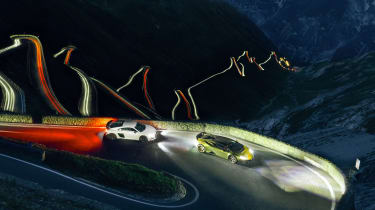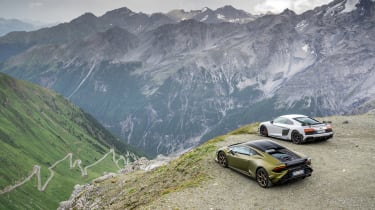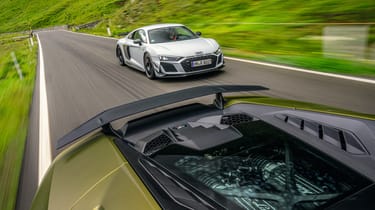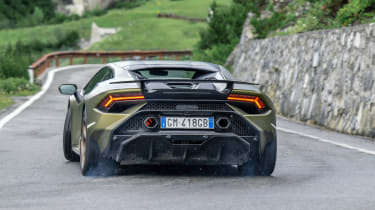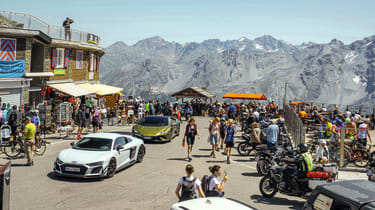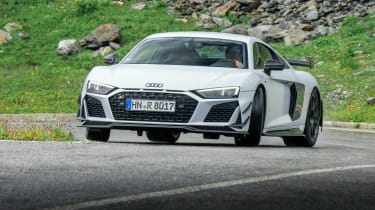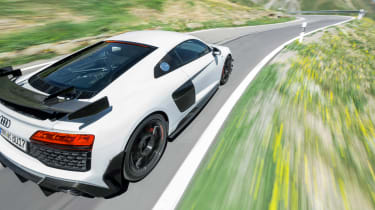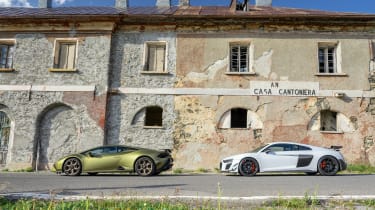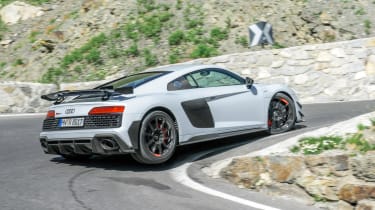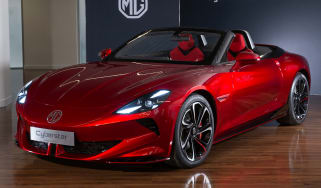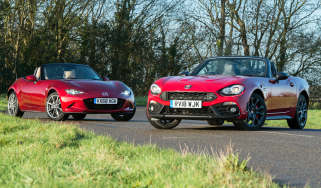Audi R8 GT RWD v Lamborghini Huracán Tecnica – the last of the V10s
As Audi’s V10 R8 and Lamborghini’s Huracán near the end of their journey, it's time for a final blast
We seem to be doing this a lot lately. Bidding farewell to cars that have been a formidable presence in our lives. This time not only is the bell tolling for the Audi R8 and Lamborghini Huracán, but also for the spectacular naturally aspirated V10 engine that powers them.
All three deserve a proper farewell, but where to take them? For a while the whole idea hangs in the balance, with neither an R8 GT RWD or Huracán Tecnica available in the UK. Then the Gods of Internal Combustion (and Google Maps) intervene. Bookings synched with Audi AG and Automobili Lamborghini’s press fleets and collection arranged from Munich and Sant’Agata respectively, all that remains is to find a suitably spectacular rendezvous point that doesn’t devour too much of our three-day trip to reach.
> Lamborghini Aventador Ultimae v Lamborghini Countach
It doesn’t take long to find our destination: Italy’s snaking, 2757-metre-high Stelvio Pass. Roughly equidistant between our German and Italian start points, it’s a brisk five-hour drive to the second highest road in Europe and one of the most famous driving destinations in the world. Yes, there are more flowing mountain passes with less traffic, but trust me, there are few more remarkable places to take any car. As a place to celebrate two of the best-sounding cars money can buy, this 30-mile mountain pass, complete with a staircase of hairpins on one side and a bunch of avalanche tunnels on the other, is hard to beat.
We meet at the summit in the early evening, dep ed James Taylor in the Audi, myself and photographer Parrott in the Lamborghini. Both cars look gloriously out of place street-parked amongst the beaten-up Subarus preferred by the locals. Rather than booking accommodation down in nearby Bormio, we’re staying in one of the small hotels found atop this famous peak. It buys us more time for photography and lends the whole trip a bit more of an adventurous edge. It also means we can grab an early dinner before attempting to create one of the main set-piece images of the trip – a long-exposure shot for the cover that will hopefully capture the scale and spectacle of this great road.
It’s a little-known fact that there are actually three Stelvios. The version most visitors see is the high-altitude theme park thronged with day-tripping cyclists, bikers, cars and campervans. Given the rapidly changing mountain weather, it’s quite possible you’ll also see its alter ego – the Stelvio cloaked in swirling cloud and wintry weather that sends everyone back down to more clement climes. However, only when darkness descends and the visitors have gone home does the most mysterious Stelvio reveal itself. Almost pitch black with few traces of human activity, the atmosphere on the pass is as eerie as you’ll experience anywhere. Never more so than when you wind your way down the corkscrew curves, down and down into the dark, away from human habitation until the summit lights are just a faint twinkle.
Thankfully I’ve got Taylor for company. The cold white beams of his R8’s headlights are bright in my rear-view mirror on the short straights but sweep the steep slopes on the far side of the escarpment like searchlights as we zig-zag our way down. We continue until our walkie-talkies crackle with Parrott’s garbled signal to stop, before turning around and parking in readiness to make our ascent.
On Aston’s signal we gun it in unison, Huracán heading R8 by a few car lengths as we begin the headlong rush back up the mountain. Unlike the daytime, where you have to approach every corner expecting a car, motorbike, cyclist or even a motorhome to be heading down towards you, the darkness means we’ll see descending traffic from miles away. Not that there is any at 10pm on a Tuesday night.
Up we climb, punching hard through the lower gears, each hairpin taken in first gear before full throttle and full revs in second gear and perhaps a fleeting burst of third before blip-shifting back down to first for the next switchback. The Huracán sounds completely outrageous, its feral howl filling the valley before bouncing back off the main wall of the north face. This is what we came here for.
The darkness and decibels mess with your senses, amplifying the sound and focusing your vision on what’s frozen in the bright daggers of main beam. Without the benefit of seeing the road rising towards the summit, your sense of place and progress relies on the writhing rhythm of the road. It creates a hypnotic cadence. One that skews your sense of time and distance until you’re approaching a heightened state of adrenalised trance.
By the time we reach Parrott’s perch on one of the uppermost hairpins, we’re absolutely buzzing. Thankfully he needs us to do another run, so we turn around and head back down before charging back up once more. Apart from a van, which passes us as we’re waiting at the bottom of the pass, we don’t see another vehicle the whole time we’re out. The second run is even better. Parrott says he’s never heard anything like it in his life, and while it’s tempting to turn around to make one last climb for some grainy hand-held iPhone video, we all decide we’ve ridden our luck enough for one night. It’s one of the most surreal and spectacular experiences I’ve ever had and something I’ll never forget. And, as our cover attests, the photo’s not bad either.
Tearing up and down in the dark might be riotous, unforgettable and unrepeatable fun, but we’ve got a lot of driving and photography ahead of us. Fortunately, there’s not much in the way of nightlife atop Europe’s second highest mountain pass, so we all retire to bed ready for a 6.30 start the following morning.
Staying at the summit affords you access to the Stelvio’s hidden after-hours routines. Pro skiers leave at dawn for the summer training slopes carved into the glacier that clings to the mountainside. Not long after, a comedically short-wheelbase refuse truck makes the tortuous ascent, its crew noisily collecting the rubbish before the roads gets busy with the next influx of tourists. Note to self: add Stelvio bin lorry driver to list of ‘World’s Greatest Jobs’.
> Electric Lamborghinis are coming, starting with the 1341bhp Lanzador
Dawn casts its light on a desolate, fascinating, weather-beaten place. Stripped of the life and colour brought by the visiting daytime hoards, it’s a bit down at heel, but the view across the valley is majestic. The chill morning air is in stark contrast to the shirt-sleeve temperatures we’ll enjoy during the afternoon, but its freshness is invigorating compared with the soupy summer heat and humidity we drove through on our way from Sant’Agata.
You get the sense that the hoteliers and skiers and cyclists who live and train up here for the summer season are hard to impress, but the sight of the Huracán and R8 causes as much of a stir as you’ll get from the hardy souls of the Südtirol. It’s blindingly obvious what we’re here for, but nobody seems to mind the presence of these raucous machines, even as their open-valved exhausts shatter the morning peace.
Before we get into the driving experiences, it’s worth comparing their specifications. Unlike early ‘pre-LP’ Gallardos, which were powered by Lamborghini’s in-house 5-litre V10 that owed nothing to Ingolstadt, the Huracán uses the same Audi-sourced 5.2-litre V10 that is also bolted into the back of the Gen 2 R8. It was at this point that both cars also received a common platform, along with a shared seven-speed twin-clutch transmission and electric power steering amongst other major hardware and electronic architecture changes.
Unsurprisingly it marked a significant shift in the characters of both cars. Neither for the better it must be said, at least initially, but slowly both Lamborghini and Audi managed to improve the co-developed package and take it in directions that suit their divergent customer demographic best. Now, as both reach the end of the road, the rough edges have been smoothed, feel has been found and powertrain pips squeezed, as befits cars honed to their keenest edge by engineering teams who wish to leave nothing on the table.
The R8 GT is arguably the most Lambo of all R8s, but it’s still shy of the Tecnica for outright firepower, with 611bhp and 411lb ft compared with 631bhp and 417lb ft. Ironically given both these cars are falling victim to the quest for Net Zero, the Audi’s power deficit and more subdued delivery are due to emissions legislation and not intra-VAG politics; Lamborghini’s sub-10k per-year production volume affords it certain emission exemptions denied to Audi, meaning it can uncork the Huracán with relative impunity while the R8 has to toe the line with party-pooping gasoline particulate filters and less aggressive fuel and ignition management.
Weight-wise, both cars are fighting fit, largely due to both of them ditching their all-wheel-drive systems. Thanks to Audi quoting kerb weight (1570kg) and Lamborghini quoting dry weight (1379kg) it’s hard to get comparable figures, but given so much of both cars is shared and neither has gone to extremes in terms of lightweight components there’s unlikely to be much in it in terms of mass.
All-out each is extremely rapid – think 0-62mph in less than 3.5sec, and top speeds separated by a few mph (the Audi’s just south of 200, the Lambo’s just north) – but neither has the monster mid-range flex of more modern turbocharged or turbo-hybrid rivals. Then again, none of those can match the magnificent response, nor the fabulous building crescendo offered by this magnificent V10. Speed might be the essence, but sound is most definitely the emotion.
Few cars have styling that expresses their character more accurately than this pair’s. The Audi is clearly influenced by motorsport, its stance and workmanlike aero package mimicking its hugely successful GT3 sibling, while the Tecnica is spectacular but leaves the road-racer vibe to its wilder-looking STO stablemate. Think of it as Lambo’s GT3 Touring. Together they serve as a monument to VAG’s resources, ambition and mastery of the platform-sharing art.
Having spent most of Day 1 in the Huracán’s cartoonish fighter-plane cockpit, it’s a real culture shock to start Day 2 in the R8. Roomier, calmer and considerably more comfortable, what it lacks in theatre it makes up for in useability. That might sound boring, but the easy ergonomics and simplicity of the driving environment are a lesson in subtlety without denying you a certain sense of occasion.
Start the engine and that feeling of restraint continues, even as the V10 warbles exuberantly on fast idle while it warms up. The shift paddles – well, rectangular buttons to be more precise – are a bit apologetic, but they operate a gearbox that feels sharper and more responsive than that of other R8s. Our test car is fitted with the GT’s optional manually adjustable coilover suspension. It’s old-school compared with modern adaptive dampers, but there’s something refreshingly confident about a car that is what it is and does what it does without the need to switch between modes. As with all R8s, the steering is calm. In fact it’s borderline slow in terms of ratio, which makes the Stelvio’s switchbacks more of an armful than in the ultra-direct Huracán, which darts into the heart of the hairpins as if guided by laser. The Audi doesn’t have the front-end bite either, so you’re more likely to feel the nose push wide in the tightest turns where the Tecnica keeps digging in.
Both cars lift their inside wheels through the steepest corners, brief flares of wheelspin triggering the ESC before both rear tyres find terra firma. Funnily enough, on the steep, tangled northern approach both the R8 and Huracán would benefit from four-wheel drive, though we’ll keep that confession between us. Both cars have sharp brakes, the Lambo’s being the trickiest to modulate smoothly. The upside is that neither suffers in the slightest from fade and their pedals remain firm and inspire absolute confidence, even under extreme use.
On the west side of the Stelvio, heading down towards Bormio, the road gradually relaxes its grip, slithering down the steepest sections in trademark style before taking a more direct route that hugs the valley wall. Open-sided tunnels offer protection from avalanches and tumbling rocks, and also provide the opportunity to enjoy our V10s in a more enclosed space. The R8 sounds fabulous – smooth, cultured and expensive – but can’t compete with the Huracán, which drowns the Audi in decibels then strafes it with gunshot pops and bangs on the overrun.
Broadly speaking, how they sound is how they drive, the Huracán delivering its performance in a more explosive and visceral manner. On warm, dry roads you can revel in the sharper reactions and more aggressive direction changes, chasing the throttle until the rear tyres relinquish their grip. The Audi’s edges are softer and consequently less of a thrill, but when the weather changes the R8 comes into its own.
And change it does. You see the storms rolling in well before they arrive. Dark and malevolent even from afar, swollen clouds circle the distant summits and prowl along the valleys with malicious intent. Most skulk by harmlessly but some strike hard and fast, tendrils of cloud taking hold of the crags as if to haul the weight of the weather up to the summit. Moments later the wind is howling, propelling the rain and hail with such force that it’s actually travelling upwards when it sweeps over the peaks. This is a wild place when it wants to be.
Having seen the maelstrom approaching, we’ve elected to swerve it, ducking into the excellent Tibet Hut to get ourselves some well-earned cake and coffee. If you’re planning a Stelvio trip, be sure to try it. Half an hour later we emerge to a very different scene. The storm has blown through, leaving the mountain drenched and cold enough to have us reaching for our coats. Sheets of water riffle across the hairpins and hail sits inches deep at the road’s margins. Cyclists who sought cover now re-emerge, keen to leave this exposed pinnacle for the valleys below, but wary of taking liberties on knife-edge tyres and slippery tarmac.
The downpour-driven exodus has its advantages, for with far fewer cyclists, motorcyclists and cars on the road it presents us with the perfect opportunity to get some action shots in the Audi. It’s a good reason to dig into the Torque Rear mode, which allows you to dial in slip angle with some underlying electronic safety. It really is uncannily good at getting the R8 to rotate under power and then slide at a significant angle with enough throttle to make it feel entirely natural and under your control.
It’s a reminder that not only can the Audi let its hair down given the chance, but that it can do so with immaculate poise and precision. Historically the four-wheel-drive R8 has felt more convincing than the RWD models – and, weirdly, happier going sideways – so the fact that Audi has finally nailed the two-wheel-drive car’s handling in this final iteration is both satisfying and a little bit sad. It certainly feels more exploitable and confidence-inspiring than the Lambo, which pays the price for its dry-road prowess with spikier and less communicative on-limit behaviour in the rain. Some of this is down to the Audi’s Michelins versus the Lamborghini’s Bridgestones, but it’s also due to differences in the calibration of throttle and stability control systems.
With the last images safely captured and both cars explored and enjoyed to the full, it’s with heavy hearts that Taylor and I point the R8 and Huracán downhill and head back towards Munich and Sant’Agata. We’ve only been in the mountains for two days and yet it feels unsettling to be descending towards the hustle and bustle of life below the clouds. As we leave the summit the temperature is a chilly 9deg C. When Parrott and I roll into Sant’Agata that afternoon the Huracán’s temperature gauge is showing 42deg C. It’s all a bit discombobulating, but the best road trips do that to you.
The finality of knowing both these cars are about to die is equally unsettling. Both are so good it seems inconceivable that they are being phased out, especially as they have an infinitesimally small impact on global carbon emissions. Yet this is where we find ourselves.
Right to the end the R8 has remained a cool customer. Less explicit in voice and dynamics, it lacks the Huracán’s raucous temperament and razor-sharp responses, preferring a more measured and cerebral approach to fulfilling the supercar brief. For some this means the GT is a missed opportunity, Audi not going far enough while it had the chance. But spend enough time with it and you’ll find hidden depths to the GT’s abilities that elevate it above all previous iterations. It’s a brilliantly executed car that brings the R8 story to a close in fine style. A battery-powered successor holds little appeal.
If the R8 GT is a full stop the Huracán Tecnica is a screaming exclamation mark. Few cars at any price are more exciting, and no modern Lamborghini has proved more adept at delivering an experience that appeals to the extrovert yet satisfies the purist. Its replacement looks set to feature a new twin-turbo V8 with battery-electric hybrid. Of course it’ll be more potent, but surplus speed feels like a poor trade when it comes at the expense of one of the great internal-combustion soundtracks. We’ll miss them when they’re gone. But while they’re here what better way to rejoice in what they represent than driving to the roof of Italy and let them scream one last time.
Specs
| Audi R8 V10 GT RWD | Lamborghini Huracán Tecnica | |
| Engine | V10, 5204cc | V10, 5204cc |
| Power | 611bhp @ 8000rpm | 631bhp @ 8000rpm |
| Torque | 411lb ft @ 6400rpm | 417lb ft @ 6500rpm |
| Weight | 1570kg | 1379kg (dry) |
| Power-to-weight | 395bhp/ton | 465bhp/ton (dry) |
| 0-62mph | 3.4sec | 3.2sec |
| Top speed | 199mph | 202mph |
| Basic price | £195,253 | £212,000 |
This story was first featured in evo issue 314.
